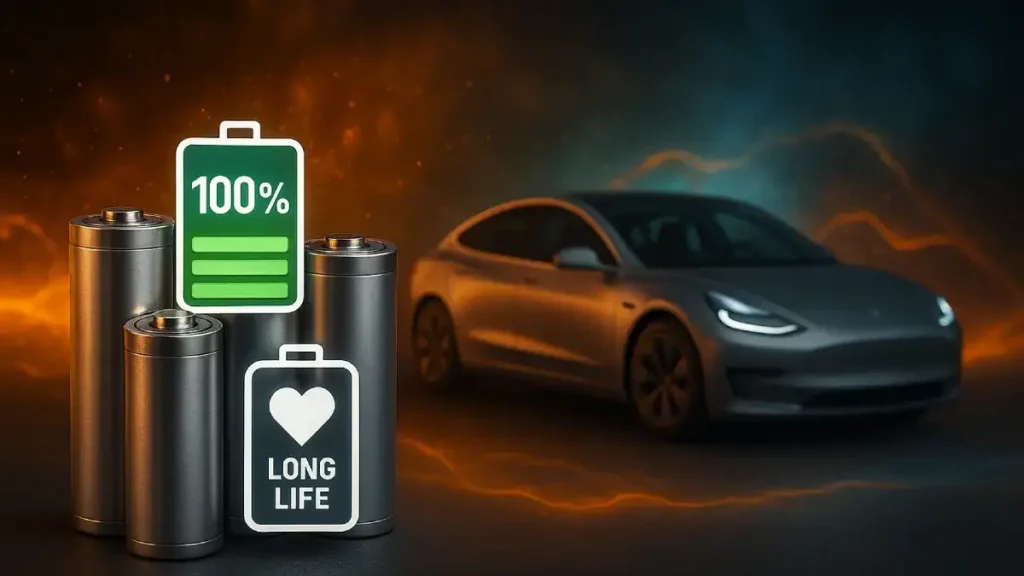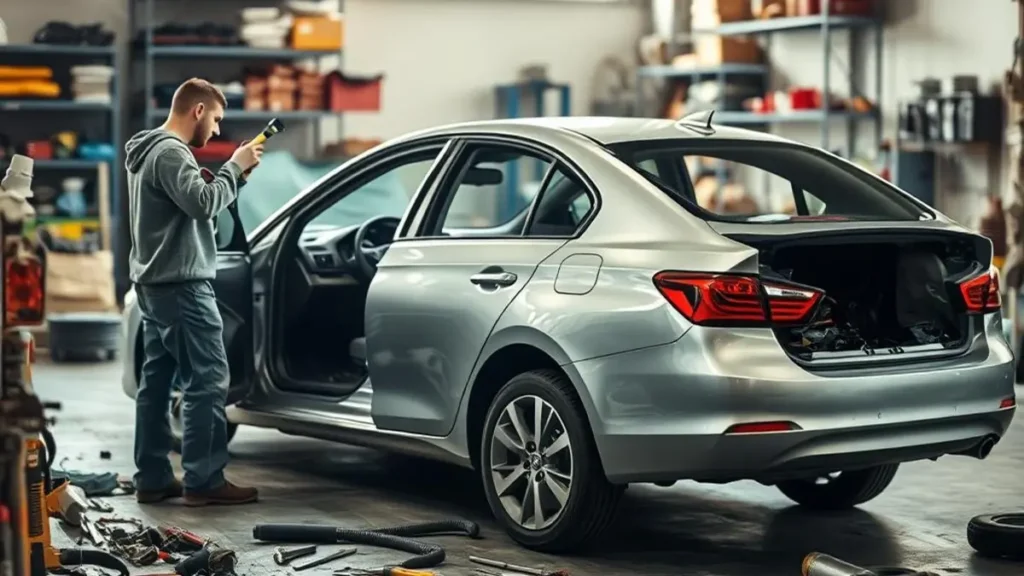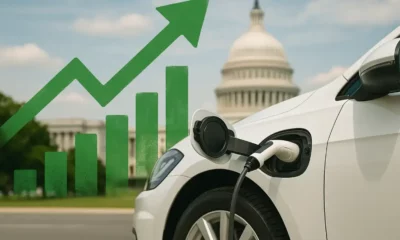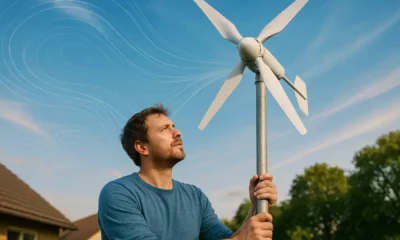Battery Technology for EVs: The Driving Force Behind Electric Vehicle Innovation
Battery Technology for EVs: The Driving Force Behind Electric Vehicle Innovation
Estimated Reading Time: 12 minutes
Key Takeaways
- Lithium-ion is Dominant: Currently, lithium-ion batteries power about 99% of Electric Vehicles (EVs) due to their high energy density and long cycle life.
- Solid-State is Next-Gen: Solid-state batteries promise higher energy density (longer range), increased safety, and potentially faster charging times, representing significant battery innovation.
- Range Anxiety Addressed: Modern EV batteries offer significant range (250-400+ miles), complemented by technologies like regenerative braking and smart energy management to extend battery life and usability.
- Charging is Evolving: Ultra-fast charging (enabled by 800V systems) drastically cuts charging times, while innovative solutions like V2G, battery swapping, and wireless charging aim for greater convenience.
- Future is Diverse & Sustainable: Research explores beyond lithium-ion (Sodium-ion, Li-S, Li-Air) focusing on cost reduction, abundance, and sustainability through recycling and cobalt-free designs.

Table of contents
- Battery Technology for EVs: The Driving Force Behind Electric Vehicle Innovation
- Key Takeaways
- Understanding Current EV Battery Technology
- Solid-State Batteries – The Next Generation
- Engineering Solutions to Range Anxiety
- Revolutionizing Charging Infrastructure
- Future Battery Technologies on the Horizon
- Conclusion: Powering the Future of Transportation
- Call to Action
- FAQ
Battery Technology for EVs is the heart of electric cars. Think of it like the engine and fuel tank combined in a regular car, but using electricity instead of gasoline. These special power systems use groups of cells to store electricity. They then send that electricity to the electric motor, which makes the car go.
This battery tech is super important. It decides how far an electric vehicle (EV) can drive on one charge (that’s called range). It also controls how fast the car can go, how quickly it can recharge, and even how much the car costs to buy. Because batteries are so vital, improvements in EV batteries are pushing the whole electric car world forward.
For a long time, old battery types couldn’t compete with gasoline cars. They didn’t store enough power, took too long to charge, or wore out too quickly. But now, scientists and engineers are making amazing progress. New Battery Technology for EVs is solving these old problems fast.
In this article, we’ll look closely at the battery tech used in today’s EVs. We’ll explore exciting new breakthroughs like solid-state batteries. We’ll also see what the future holds for powering our electric journeys.
“The battery isn’t just a component; it’s the core enabler of the electric revolution on wheels.”
Understanding Current EV Battery Technology
The Lithium-Ion Era: Powering Today’s EV Batteries
Right now, almost every electric car you see uses a type called lithium-ion battery. About 99% of EVs rely on this battery tech.
What’s inside these EV batteries? They have four main parts:
- Cathode: The positive side.
- Anode: The negative side.
- Separator: A thin sheet that keeps the cathode and anode apart.
- Electrolyte: A special liquid that tiny bits called lithium ions can swim through.
When you charge the battery, lithium ions move from the cathode, through the electrolyte, to the anode. When you drive the car, the ions move back the other way, creating electricity to power the motor.
Why are lithium-ion batteries so popular? Experts say it’s because they have several big advantages:
- High Energy Density: They can store a lot of energy in a small, light package. This helps cars drive farther.
- Long Cycle Life: They can be charged and emptied many times before they start to wear out.
- Low Self-Discharge: They don’t lose much power when the car is just sitting parked.
These features made lithium-ion the best choice for powering the electric car revolution we see today.
Key Performance Metrics for EV Batteries and Battery Life
How do we tell if an EV battery is good? We look at several important things, or metrics. These metrics define the battery technology for EVs:
-
- Energy Density: This tells us how much electrical energy the battery can hold for its size or weight. It’s usually measured in watt-hours per kilogram (Wh/kg). Today’s EV batteries often have an energy density of 250-300 Wh/kg. Higher energy density means the car can drive farther (longer range) without the battery getting too big or heavy.
-
- Thermal Management: Batteries can get hot when charging quickly or working hard (like going up a hill). They can also get too cold in winter. Thermal management means systems that keep the battery at the right temperature. This is vital for safety (preventing overheating) and helps the battery last longer and perform better. Good temperature control prevents damage.
-
- Cycle Life: This is how many times you can fully charge and discharge the battery before it loses too much of its ability to hold energy. We usually say the battery is ‘worn out’ when it can only hold 80% of its original charge. Modern EV batteries typically have a cycle life of 1,000 to 2,000 cycles. This means they can last for many years.
- Power Density: This measures how quickly the battery can deliver energy. High power density is needed for fast acceleration, letting the car zoom quickly when you press the pedal. It affects the car’s sporty feel and overall performance.
How long do current EV batteries last? They are getting much better. On average, they lose about 1.8% of their ability to hold charge each year. With good care and normal driving, many EV batteries are expected to last 15 to 20 years. This focus on battery life is key for car owners.
“Understanding these metrics isn’t just for engineers; it helps drivers choose the EV that best fits their needs and expectations.”
Solid-State Batteries – The Next Generation
What Makes Solid-State Batteries Different with Battery Innovation?
Scientists are working on a very exciting new type of battery called solid-state batteries. These could be a huge leap forward in battery innovation.
The big difference is inside. Remember how current lithium-ion batteries use a liquid electrolyte for lithium ions to swim through? Solid-state batteries replace that liquid with a thin layer of solid material. This solid electrolyte still lets the ions move, but it changes everything.
Think of it like replacing a water-filled pouch with a solid block that does the same job. This simple change brings amazing benefits:
-
- Much Higher Energy Density: Solid electrolytes allow for different battery designs that can pack much more energy into the same space. Experts think solid-state batteries could reach over 500 Wh/kg, almost double what we have today. This means EVs could drive much farther on a single charge.
-
- More Safety: The liquid electrolyte in current batteries can be flammable. Getting rid of it makes solid-state batteries much safer and less likely to catch fire.
-
- Better Temperature Handling: These batteries can handle hotter temperatures without getting damaged or losing performance. This makes thermal management easier.
- Faster Charging?: The solid structure might allow ions to move more quickly, potentially leading to super-fast charging speeds.
This new type of power storage represents significant battery innovation for the future of electric cars.
Real-World Performance Benefits of Solid-State Batteries and Charging Times
What could solid-state batteries actually mean for drivers? The improvements could be huge.
First, imagine driving much farther. Because solid-state batteries could hold nearly twice the energy of today’s EV batteries, a car that now goes 300 miles might be able to go 500 or 600 miles on a single charge. This could almost eliminate range anxiety.
Next, think about charging. Waiting for an EV to charge can be annoying. Current fast chargers can take 30-40 minutes to add a lot of range. But solid-state batteries could dramatically cut down charging times. Some designs might allow charging up to 80% full in just 10 to 15 minutes. That’s almost as fast as filling a gas tank! For deeper information on charging times and related topics, you can explore our guide on EV charging: costs, home stations, and saving with rebates.
And what about battery life? These new batteries are expected to last much longer. Some studies suggest they could handle up to 5 times more charge and discharge cycles than current lithium-ion batteries before wearing out. This means the battery could easily last the entire life of the car, maybe even longer.
“Imagine an EV needing only a 10-minute charge stop for another 400 miles. That’s the game-changing potential of solid-state batteries.”
Big car companies know how important this is. Companies like Toyota, Volkswagen, and BMW are spending billions of dollars to develop solid-state batteries. They hope to start putting them in cars around 2026 or 2027. This huge investment shows how promising this technology is.
Commercialization Challenges for New Battery Tech
While solid-state batteries sound amazing, they aren’t in our cars just yet. There are still some big challenges to overcome before they become common battery tech.
One major hurdle is manufacturing. Making these batteries on a huge scale, enough for millions of cars, is proving difficult and expensive. The special solid electrolyte materials can be hard to produce consistently in large, thin sheets. Factories need new machines and processes. This is a key focus of current battery innovation.
Another technical problem is the connection, or interface, between the solid electrolyte and the solid electrodes (cathode and anode). It’s harder to get a perfect, stable connection with solids compared to a liquid electrolyte that flows into every nook and cranny. Poor contact can slow down charging and reduce battery life.
Some types of solid-state batteries also work best at higher temperatures than normal. Engineers need to figure out how to make them work well in all weather conditions, from freezing cold to boiling hot, without needing extra complex heating or cooling systems.
Finally, there’s the cost. Right now, making a solid-state battery is estimated to cost 2 or 3 times more than making a standard lithium-ion battery. For EVs to be affordable for everyone, the cost of this new battery tech needs to come down significantly.
Researchers and companies are working hard to solve these problems. They are finding new materials, improving manufacturing methods, and designing batteries clever ways. Progress is being made, but it will take time before solid-state batteries are ready for the mass market.
Engineering Solutions to Range Anxiety
The Psychology and Reality of Range Concerns and EV Batteries
Have you ever worried about running out of gas? For electric car drivers, a similar worry is called range anxiety. It’s the fear that your EV won’t have enough battery charge to reach your destination or the next charging station. For families considering an EV, understanding range is crucial; our guide to choosing the right electric vehicle for your family offers insights into range and other important factors.
This fear was a big problem early on. The first popular EVs maybe only went 100 miles or so. But EV batteries have improved a lot! Just five years ago, many affordable EVs had a range of 100-150 miles. Today, many standard models can easily go 250-300 miles on a charge. Premium EVs can often travel 350-400 miles or even more.
And the technology keeps getting better. Scientists are developing new EV batteries with even higher energy density. Some experimental battery tech has already shown cars capable of traveling an incredible 1,100 miles on a single charge in tests! While these aren’t widely available yet, they show what’s possible.
So, while range anxiety is a real feeling, the actual range of modern EVs is often more than enough for daily driving and even many road trips, especially as charging stations become more common. The reality of EV range is rapidly catching up to, and sometimes exceeding, driver needs.
“Range anxiety is fading as battery density increases and charging infrastructure expands. The fear is becoming less about ‘if’ you’ll make it, and more about planning convenient stops.”
Complementary Technologies Extending Range and Battery Life
Making better EV batteries is the main way to increase range, but it’s not the only way engineers are fighting range anxiety. Several other clever technologies work alongside the battery to squeeze out extra miles and improve battery life.
-
- Regenerative Braking: When you slow down or go downhill in an EV, the electric motor can work like a generator. Instead of using friction brakes (which waste energy as heat), regenerative braking captures some of the car’s motion energy and sends it back into the battery. This clever system can add roughly 10% to 15% back to your effective range in city driving. It’s like getting free miles!
-
- Adaptive Energy Management Software: Modern EVs have smart computer brains. This software constantly watches how you drive, the route you’re taking (are there hills coming up?), the outside temperature, and how much charge is left. It cleverly adjusts things like heating, cooling, and power delivery to use the battery energy as efficiently as possible. This optimization helps maximize the distance you can travel. This smart battery tech makes a real difference.
- Battery Thermal Management Systems: We mentioned this earlier, but it’s crucial for range too. Batteries work best within a specific temperature range. If it’s too cold or too hot, they can’t deliver as much power or hold as much charge efficiently. Advanced thermal management systems use heating or cooling circuits to keep the EV batteries at their happy temperature. This maintains optimal performance and range, even in extreme weather, while also protecting the battery life.
These complementary technologies work together with the advancements in core battery tech to give drivers more confidence and less range anxiety.
Revolutionizing Charging Infrastructure
Ultra-Fast Charging Technology and Charging Times
Waiting for an EV to charge can feel like a long time compared to filling a gas tank. That’s why making charging times shorter is a huge focus for engineers. One big change is using higher voltage electrical systems in cars and chargers.
Many older EVs used a 400-volt (400V) system. Newer cars, especially premium ones, are moving to 800-volt (800V) systems. Think of voltage like water pressure – higher voltage can push more electrical energy into the battery faster.
This allows for “ultra-fast” charging stations. These powerful chargers can deliver up to 350 kilowatts (kW) of power. With an 800V car that can accept this power, you could add around 200 miles of driving range in just 15 minutes! This makes long road trips much easier.
And the future looks even faster. Remember those solid-state batteries we talked about? Because they can handle heat better and potentially move ions quicker, some prototypes aim to reduce charging times even more. The goal is to get an 80% charge in only 10 to 15 minutes. This kind of speed would make charging almost as convenient as stopping for gas. Advancements in battery tech are directly linked to faster charging.
Innovative Charging Solutions and Battery Innovation
Besides making charging faster, companies are developing entirely new ways to charge EVs, showing real battery innovation in how we get power.
-
- Bidirectional Charging (V2G / V2H): This is super clever. “V2G” means Vehicle-to-Grid, and “V2H” means Vehicle-to-Home. With this technology, your EV doesn’t just take power from the grid or your house – it can also send power back! Imagine your car powering your home during a blackout (V2H), much like a Tesla Powerwall can provide energy storage solutions for homes. Or, picture thousands of EVs sending power back to the electricity grid during times of high demand, helping to stabilize the grid and potentially earning you money (V2G). Your car becomes a mobile power source.
-
- Battery-Swapping Stations: Instead of waiting to recharge your battery, what if you could just swap it for a fully charged one? Some companies are building stations where robotic arms can remove your depleted battery and insert a fresh one in less than 5 minutes. This completely eliminates waiting time, making it faster than filling a gas tank. This approach changes the focus from charging times to swapping times.
- Wireless Charging: Imagine just parking your EV in a special spot in your garage or a parking lot, and it starts charging automatically – no plugs needed! Wireless charging uses magnetic fields to transfer energy from a pad on the ground to a receiver on the bottom of the car. While it’s generally slower than plugging in right now, it offers amazing convenience. You just park and forget. This is another area of active battery innovation.
These new ideas, combined with faster plug-in charging, aim to make refueling an EV easier, more convenient, and even more useful than refueling a gasoline car.
“The future isn’t just about better batteries inside the car; it’s about smarter, faster, and more flexible ways to get energy into them.”
Future Battery Technologies on the Horizon
Beyond Lithium-Ion and Solid-State: Battery Innovation Ahead
While lithium-ion is king today and solid-state is the next big hope, scientists are already working on even more advanced battery tech. This ongoing battery innovation could lead to even better EVs in the future. Here are a few exciting possibilities:
-
- Sodium-Ion Batteries: Lithium is effective, but it’s relatively rare and expensive. Sodium, on the other hand, is one of the most abundant elements on Earth (think table salt!). Sodium-ion batteries work in a very similar way to lithium-ion but use sodium ions instead. They might not store quite as much energy initially, but they could be significantly cheaper to make – potentially 30% to 40% less expensive. They also avoid using some controversial materials like cobalt. This could lead to more affordable EVs.
-
- Lithium-Sulfur Batteries (Li-S): Sulfur is another cheap and abundant material. Li-S batteries have the theoretical potential to store much more energy than lithium-ion – perhaps 2 to 3 times the energy density. Imagine EVs that could go 700 or 800 miles on a charge! The theoretical maximum energy density is huge: around 2,567 Wh/kg compared to about 260 Wh/kg for current lithium-ion. However, there are challenges with durability (they tend to wear out faster) that researchers are working hard to solve.
- Lithium-Air Batteries (Li-Air): These are sometimes called the “ultimate” battery technology. They work by reacting lithium with oxygen from the air. Theoretically, they could store an incredible amount of energy, potentially getting close to the energy density of gasoline! The theoretical limit is around 11,680 Wh/kg. This could mean EVs with ranges over 1000 miles, weighing much less than today’s cars. However, Li-Air batteries are still very experimental and face significant scientific hurdles related to efficiency and lifespan.
These are just a few examples of the amazing battery innovation happening in labs around the world. The quest for better energy storage is far from over.
Sustainable Battery Development for EV Batteries
Making millions of EV batteries raises important questions about the environment and resources. Where do the materials come from? What happens to batteries at the end of their life? Thankfully, sustainability is a big focus of battery innovation. Embracing eco-friendly gadgets and innovations is crucial for a sustainable future, and this extends to the development and lifecycle of EV batteries.
-
- Recyclable Materials and Design: Researchers and companies are finding better ways to recycle old EV batteries. They are developing processes to recover valuable materials like lithium, cobalt, and nickel so they can be reused in new batteries. They are also designing batteries from the start to be easier to take apart and recycle. The goal is a “circular economy” where materials are reused again and again, reducing waste and the need for new mining.
-
- Structural Battery Concepts: This is a really cool idea. Instead of having a separate, heavy battery pack, what if parts of the car’s body could also store energy? Engineers are exploring “structural batteries” where energy storage materials are built right into panels like the car floor, roof, or door panels. This could save a lot of weight and space, making the EV more efficient and potentially increasing range. It combines the job of structure and energy storage.
- Cobalt-Free Cathode Designs: Cobalt is a common material in the cathode of many lithium-ion batteries. However, mining cobalt has faced criticism regarding environmental impact and working conditions in some parts of the world. There’s a huge push in battery innovation to create high-performance cathodes that use little or no cobalt. New chemistries using more nickel, manganese, or iron phosphate are becoming increasingly common, offering good performance without the ethical concerns associated with cobalt.
These efforts aim to make EV batteries not just powerful and long-lasting, but also kinder to the planet throughout their entire lifecycle.
Industry Forecasts and Timelines for Battery Tech
The world of battery tech is moving incredibly fast. Experts are watching closely and making predictions about where things are headed for EV batteries. For insights into the broader context of renewable energy and government incentives that support the growth of technologies like EV batteries, explore our guide to solar energy tax credits.
-
- Falling Costs: One of the biggest trends is the falling price of batteries. Just a few years ago, the battery pack was the most expensive part of an EV. Costs have dropped dramatically thanks to better manufacturing and larger production volumes. In 2023, the average cost was around $130 per kilowatt-hour (/kWh) of capacity. Experts predict this will continue to fall, possibly reaching below $80/kWh by the year 2030. Cheaper batteries mean cheaper EVs, making them affordable for more people.
-
- Improving Performance: Battery performance, especially energy density, is expected to keep getting better. While big leaps like solid-state are on the horizon, even standard lithium-ion battery tech is improving steadily. Projections suggest energy density will increase by about 5% to 8% each year over the next decade. This means longer range EVs year after year.
- Massive Production Growth: To power all the new EVs being planned, the world needs to make a LOT more batteries. Global battery production capacity was around 500 gigawatt-hours (GWh) in 2022. Forecasts predict this will explode, potentially reaching over 3,000 GWh by 2030. That’s a six-fold increase! Huge new “gigafactories” are being built all over the world to meet this demand.
These trends paint a clear picture: EV batteries will become cheaper, better, and much more plentiful in the coming years, accelerating the shift to electric transportation.
Conclusion: Powering the Future of Transportation with Battery Technology for EVs
Battery Technology for EVs has come an incredibly long way. What was once a major limitation, holding back electric cars, is now the main engine driving their adoption across the globe. The pace of change has been stunning.
We’ve seen how lithium-ion batteries became the standard, powering millions of EVs today. But the story doesn’t end there. Exciting breakthroughs, especially in areas like solid-state batteries, promise to solve lingering concerns consumers might have. Worries about driving range, long charging times, and how long the battery will last (battery life) are being directly addressed by relentless battery innovation.
“The journey of EV battery tech mirrors the path to a sustainable future – constantly evolving, overcoming obstacles, and driving towards a cleaner tomorrow.”
Looking ahead, the improvements won’t stop. From sodium-ion to lithium-sulfur and even lithium-air, scientists are exploring new frontiers in energy storage. Alongside this, a strong focus on sustainability, recycling, and eliminating problematic materials ensures that this electric future is also a greener one. Continued investment in research and development for Battery Technology for EVs is absolutely essential to unlock the full potential of clean, efficient electric mobility. Like the broader move towards sustainable tech solutions, advancements in EV batteries are paving the way for a greener future.
The advancements we’re seeing are not just small steps; they are transforming the automotive landscape. With better, cheaper, and longer-lasting batteries on the way, it seems very likely that electric vehicles, powered by ever-improving battery tech, will become the main way we get around within the next ten years.
Call to Action
The world of battery tech is changing fast, and it’s reshaping how we think about cars and transportation. Keep an eye on the news about developments in EV batteries – it’s an exciting field to follow!
As this technology continues to improve, think about how these advancements might affect your choices. Could your next car be electric? Understanding the progress in battery tech can help you decide when the time is right for you to make the switch to electric driving.
FAQ
Q: What is the main battery type used in EVs today?
A: Currently, lithium-ion batteries are the dominant technology, used in approximately 99% of electric vehicles due to their high energy density and good cycle life.
Q: What are solid-state batteries and why are they important?
A: Solid-state batteries replace the liquid electrolyte in lithium-ion batteries with a solid material. They promise significant improvements like higher energy density (longer range), enhanced safety (non-flammable), and potentially much faster charging times. They are considered the next major evolution in EV battery tech.
Q: How long does an EV battery typically last?
A: Modern EV batteries are designed to last a long time, often 15-20 years. They typically lose capacity very gradually (around 1.8% per year on average) and often come with warranties covering 8-10 years or 100,000+ miles. Battery life depends on factors like charging habits and climate.
Q: Do solid-state batteries charge faster?
A: Theoretically, yes. The solid electrolyte might allow for faster ion movement and better heat management, potentially enabling charge times of 10-15 minutes for an 80% charge. However, this is still under development and depends on the final commercial designs.
Q: Are there more sustainable battery options being developed?
A: Yes, significant research focuses on sustainability. This includes developing batteries using more abundant and ethically sourced materials (like sodium-ion or cobalt-free cathodes), designing batteries for easier recycling, and exploring concepts like structural batteries to reduce overall vehicle weight and material use.
ACV vs Repair Cost: Understand Your Options After a Car Accident
Estimated reading time: 8 minutes
Key Takeaways
- Insurers total a vehicle when repair costs hit 70-75% of its Actual Cash Value (ACV).
- ACV is calculated by subtracting depreciation from the replacement cost and adjusting for market factors.
- Hidden damage discovered during repairs can increase costs, potentially leading to a total loss declaration.
- Negotiating with insurers using documented evidence can improve settlement payouts.
- Consider long-term reliability and financial implications before deciding to repair or accept a total loss settlement.
Navigate to What Matters

Introduction
After an accident, you face a critical financial decision: repair your vehicle or accept an insurance payout? Understanding the relationship between ACV vs repair cost can save you thousands of dollars and prevent costly mistakes.
Actual Cash Value (ACV) represents what your car is worth today, not what you paid for it. It factors in depreciation and current market conditions to determine your vehicle’s present value.
“The key to a successful claim is understanding how insurance companies assess damage and value vehicles.”
Understanding ACV vs Repair Cost
Repair cost, on the other hand, is the total expense required to restore your vehicle to its pre-accident condition, including parts, labor, and other necessary services.
When these two figures collide during the claims process, you need to understand how insurers make decisions and how you can protect your financial interests. See this information.
How Insurers Determine Total Loss
When insurance companies evaluate accident damage, they use a specific formula to decide whether your car is a “total loss” or worth repairing.
Most insurers follow the total loss threshold formula: if repair costs exceed 70-75% of your vehicle’s ACV, they’ll declare it a total loss. For example, if your car is worth $10,000, repairs exceeding $7,000-$7,500 would likely trigger a total loss declaration.
The evaluation process typically includes:
- Initial damage assessment by an insurance adjuster
- Detailed repair estimates from body shops
- Vehicle valuation based on make, model, year, and condition
- Calculation of the repair-to-value ratio
Different states have varying legal thresholds for total loss declarations. Some use a straight percentage (like 75%), while others use a Total Loss Formula (TLF) that considers salvage value alongside repair costs. For further reading on this, see our guide on understanding the total loss threshold by state (Total Loss Threshold by State).
Understanding how insurers determine total loss empowers you to question their assessment if you believe it’s unfair or inaccurate. Learn more (LINK TEXT) [https://www.kbb.com/car-advice/actual-cash-value/].
Actual Cash Value Car Calculation Explained
The actual cash value car calculation uses a relatively straightforward formula:
ACV = Replacement Cost – Depreciation + Market Adjustments
Replacement cost refers to what you’d pay for an identical vehicle in today’s market. Depreciation accounts for the vehicle’s decreased value over time, influenced by:
- Vehicle age (typically 15-25% depreciation in the first year)
- Mileage (high mileage accelerates depreciation)
- Pre-existing damage or wear
- Maintenance history
- Previous accidents
Market adjustments consider local market conditions, vehicle popularity, and special features that might increase value. To maximize your appeal, see what’s the best time to sell a car (Best Time to Sell a Car).
For example, a 2018 sedan with an original price of $25,000 might have a replacement cost of $20,000 today. With $8,000 in depreciation due to age, mileage, and condition, plus $1,000 in positive market adjustments for desirable features, the ACV would be:
$20,000 – $8,000 + $1,000 = $13,000
Understanding this calculation helps you verify whether your insurer’s valuation is fair and accurate. Find out more information (LINK TEXT) [https://www.experian.com/blogs/ask-experian/actual-cash-value-vs-replacement-cost-for-car-insurance/].
Interactive ACV Estimator Tool
To quickly estimate your vehicle’s ACV and compare it against repair costs, follow this simplified calculation:
- Find similar vehicles for sale in your area (check Kelley Blue Book or local listings)
- Calculate the average asking price
- Subtract for negative factors:
- Deduct 10-15% for high mileage (over 12,000 miles per year)
- Deduct 5-10% for poor condition
- Deduct 5-15% for accident history
- Add for positive factors:
- Add 3-5% for recent major repairs or upgrades
- Add 2-5% for desirable features
Let’s use this formula to compare ACV vs repair cost in a real-world scenario:
A 2017 Honda Accord with 70,000 miles has an average listing price of $16,500. With slightly high mileage (-5%) and good condition, the estimated ACV is $15,675. If repair costs after an accident are $12,000, that’s approximately 77% of the ACV—likely making it a total loss.
See also these examples.
Supplements and Hidden Damage
One of the most common complications in the ACV vs repair cost evaluation is the discovery of hidden damage after repairs begin. These additional repair costs, called “supplements,” can push a repairable vehicle over the total loss threshold.
Supplements typically occur when:
- Structural damage becomes visible only after disassembly
- Damaged parts reveal additional problems
- Safety systems require recalibration
- Parts availability issues increase labor costs
For example, what initially appears as $8,000 in repairs on a $12,000 vehicle (67% of ACV) might increase to $9,500 with supplements, pushing it to 79% and triggering a total loss declaration.
To protect yourself, ask the body shop for a thorough preliminary inspection and request they note potential hidden damage areas that could affect how insurers determine total loss.
Negotiation Tactics for Better Payouts
When facing a total loss situation, you don’t have to accept the first ACV offer from your insurer. Consider these negotiation strategies:
- Gather evidence of your vehicle’s value with screenshots of comparable vehicles for sale in your area
- Document recent improvements like new tires, brakes, or other major components
- Obtain an independent appraisal if the difference is significant
- Present maintenance records showing above-average care
- Research unique features that might increase value
- Consider the car’s pre-accident condition compared to average
The actual cash value car calculation isn’t set in stone. By presenting compelling evidence, you can often increase the insurer’s offer by 5-15%, potentially adding hundreds or thousands to your settlement.
Remember that adjusters initially aim for the lower end of the value range. Your documented research creates leverage for negotiation. If you decide to sell your car, review CarMax vs Carvana (CarMax vs Carvana Comparison) and decide where to sell it and get more money.
Decision-Making Tools
When weighing whether to repair your vehicle or accept a total loss settlement, consider using these resources:
- Replacement Vehicle Checklist: Compare your settlement amount against available replacement options in your market
- Instant Cash Offer tools: Get immediate valuations from services like Kelley Blue Book to verify the fairness of insurer offers
- Cost-benefit analysis: Consider future reliability and safety against the settlement amount
The ACV vs repair cost decision isn’t just about current numbers—it’s about future value and reliability. Sometimes accepting a total loss makes financial sense even when the threshold hasn’t been reached, especially with older vehicles where repair quality might not restore full functionality. After an accident, you may qualify for a diminished value claim (Diminished Value Claim Guide).
See this additional advice.
Below are answers to frequently asked questions about **ACV vs repair cost** decisions.
Understanding Total Loss Threshold by State and What It Means for Your Vehicle
Estimated reading time: 7 minutes
Key Takeaways
- Total loss thresholds vary by state, impacting insurance claim outcomes.
- Insurance companies use either a percentage rule or a formula to determine if a vehicle is a total loss.
- Understanding your state’s specific rules can help you negotiate a fair settlement.
Navigate to What Matters
![what to do if car is totaled [state]](https://nowee.org/wp-content/uploads/2025/09/image_0-1024x576.webp)
Introduction
When your car is damaged in an accident, insurance companies use the total loss threshold by state to determine if your vehicle should be repaired or declared a total loss. This critical percentage varies significantly depending on where you live, directly impacting your insurance claim outcome.
The total loss threshold is essentially the point at which repair costs exceed a certain percentage of your vehicle’s actual cash value (ACV). Understanding your state’s specific rules can help you navigate insurance claims more effectively and ensure you receive fair compensation.
“Each state follows either a specific percentage rule or a formula to determine when a car is considered totaled. These thresholds range from as low as 70% to as high as 100% of your car’s value.”
How Insurance Companies Determine Total Loss
Insurance providers typically use one of two methods to decide if your vehicle is a total loss:
The Totaled Car Percentage Rule
Many states establish a specific percentage threshold. When repair costs exceed this percentage of your vehicle’s ACV, the car must be declared a total loss.
For example, if your car has an ACV of $10,000 and your state’s threshold is 75%:
- Repair costs of $7,600 would exceed the threshold
- The vehicle would be declared totaled
- You would receive a settlement based on the ACV
The Total Loss Formula (TLF)
Some states use a formula rather than a fixed percentage. The formula works like this:
Cost of Repairs + Salvage Value ≥ Actual Cash Value = Total Loss
For example, if your $10,000 car needs $6,000 in repairs and has a salvage value of $4,500:
- $6,000 (repairs) + $4,500 (salvage) = $10,500
- Since $10,500 exceeds the $10,000 ACV, the car is totaled
This method considers both repair costs and what the vehicle would be worth as salvage; see this explanation.
State-by-State Total Loss Threshold Table
Use this quick reference guide to find your state’s specific threshold requirements:
| State | Threshold | Method |
|---|---|---|
| Alabama | 75% | Percentage of ACV |
| Alaska | TLF | Total Loss Formula |
| Arizona | TLF | Total Loss Formula |
| Arkansas | 70% | Percentage of ACV |
| California | TLF | Total Loss Formula |
| Colorado | 100% | Percentage of ACV |
| Connecticut | TLF | Total Loss Formula |
| Delaware | TLF | Total Loss Formula |
| Florida | 80% | Percentage of ACV |
| Georgia | 75% | Percentage of ACV |
| Hawaii | TLF | Total Loss Formula |
| Idaho | TLF | Total Loss Formula |
| Illinois | TLF | Total Loss Formula |
| Indiana | 70% | Percentage of ACV |
| Iowa | 75% | Percentage of ACV |
| Kansas | 75% | Percentage of ACV |
| Kentucky | 75% | Percentage of ACV |
| Louisiana | 75% | Percentage of ACV |
| Maine | TLF | Total Loss Formula |
| Maryland | 75% | Percentage of ACV |
| Massachusetts | TLF | Total Loss Formula |
| Michigan | 75% | Percentage of ACV |
| Minnesota | 70% | Percentage of ACV |
| Mississippi | TLF | Total Loss Formula |
| Missouri | 80% | Percentage of ACV |
Notable outliers include Texas with a 100% threshold, meaning repair costs must equal or exceed the full value of the car before it’s totaled, while Arkansas has one of the lowest thresholds at 70%.
Always verify current salvage threshold requirements for your specific state as regulations can change.
What Happens When Your Car Exceeds the Threshold
When your vehicle’s damage exceeds your state’s total loss threshold, several important processes begin:
Insurance Payout Based on ACV
Your insurance company will offer you a settlement based on your car’s Actual Cash Value, not the replacement cost. This valuation considers:
- Original purchase price
- Depreciation based on age
- Mileage and condition before the accident
- Recent sales of similar vehicles in your area
This payout is often negotiable if you can prove your car was worth more than the insurer’s initial offer.
Salvage Title Implications
Once declared a total loss, your vehicle will receive a salvage title designation. This classification has significant consequences:
- The car cannot be legally driven on public roads
- Most insurance companies won’t cover a salvage vehicle
- Resale value drops considerably
- Registration requires special inspections in most states
Understanding your state’s salvage threshold is crucial because this title status follows the vehicle permanently, even if repaired.
Smart Steps After a Total Loss Declaration
If your vehicle has been declared a total loss, take these proactive steps:
Verify the Assessment
Double-check that your car truly exceeds your state’s total loss threshold. Request detailed documentation showing:
- The complete repair cost estimate
- The calculation method used
- Your vehicle’s pre-accident value determination
Many insurers use third-party valuation tools that may undervalue your vehicle.
Negotiate Effectively
Don’t accept the first offer. To improve your negotiating position:
- Research comparable vehicles in your area
- Gather maintenance records showing your car’s excellent condition
- Document recent upgrades or new parts
- Get an independent appraisal if significant money is at stake
Remember, the totaled car percentage rule in your state establishes the minimum threshold, but you can still advocate for fair compensation. For assistance, see this overview.
Replacement Options
After accepting your vehicle’s total loss status, consider these replacement options:
Research Alternatives
Start your search for a replacement vehicle by:
- Comparing similar models within your settlement budget
- Checking both new and used inventory
- Considering certified pre-owned options with warranties
- Exploring lease takeovers for potential savings
Buyback Considerations
In many states, you can “buy back” your totaled vehicle from the insurance company:
- The insurer deducts the salvage value from your settlement
- You keep the damaged car along with a reduced payout
- The vehicle retains its salvage title status
- You’re responsible for repairs and special inspections
This option makes sense if your car has sentimental value or you believe you can repair it cost-effectively. More information can be found at Policygenius.
Conclusion
Understanding the total loss threshold by state empowers you to navigate insurance claims with confidence. These thresholds vary significantly across the country, with some states using strict percentage rules while others employ more complex formulas.
When facing a potential total loss situation, knowledge of your state’s specific requirements helps you verify insurance assessments and negotiate fair settlements. Remember that these thresholds establish minimum standards, but you always have the right to question valuations and repair estimates.
Take time to review your state’s particular total loss threshold before accepting any settlement offer. This simple step can potentially save you thousands of dollars and help you make more informed decisions about your vehicle’s future. Here is a quick checklist (48-Hour Checklist if Your Car is Totaled [State]); see this page for total loss appraisals.
Related reading:
- Understand the forces behind electric vehicle adoption (How Government Policies Impact EV Adoption)
- You may want to review diminshed value claim in your state (Diminished Value Claim [State]: Your Complete Guide to Recovering Lost Vehicle Value).
- Are you considering an electric car? (Choosing the Right Electric Vehicle: The Ultimate Guide for Families)
- Learn more about EV battery innovations (Battery Technology for EVs: The Driving Force Behind Electric Vehicle Innovation).
- Thinking about reducing waste? (Reducing Food Waste: How AI and Smart Kitchen Technology Are Transforming Sustainable Living)
Below are quick answers to common questions about total loss thresholds.
FAQs
How to Sell a Leased Car to CarMax: Step-by-Step Third-Party Payoff Guide
Estimated reading time: 7 minutes
Key Takeaways
- Selling a leased car to CarMax is possible via a third-party payoff.
- Not all leasing companies allow third-party payoffs; check your lease agreement.
- Equity can be captured if CarMax’s offer exceeds your lease payoff amount.
Introduction
Are you wondering if you can sell your leased car to CarMax and possibly walk away with some extra cash? The good news is that selling a leased car to CarMax is entirely possible through a process called third-party payoff.
With rising vehicle costs and market values, many drivers are discovering they have equity in their leased vehicles. This creates an opportunity to exit your lease early while potentially pocketing the difference between your car’s current value and the remaining lease payoff.
Let’s explore exactly how to sell a leased car to CarMax, navigate the third-party payoff process, and maximize your potential returns.
Navigate to What Matters

“Selling your leased car can be a win-win situation.”
Understanding Third-Party Lease Payoffs
A third-party lease payoff is the mechanism that allows you to sell your leased vehicle to CarMax without buying it yourself first. This process enables CarMax to purchase the vehicle directly from your leasing company.
When you sell a leased car to CarMax, they contact your lender to obtain the exact payoff quote. CarMax then handles the payment directly to your leasing company and manages any equity distribution if your car is worth more than the payoff amount.
However, not all leasing companies allow third-party payoffs. Some manufacturers and finance companies have implemented restrictions that require you to buy the car yourself before selling it. Honda, Acura, GM, and BMW are examples of brands that have placed such restrictions in recent years.
Your equity calculation is simple: the difference between CarMax’s offer and your lease payoff amount. If the offer exceeds your payoff, you receive the difference as profit. For more clarity on your options, explore (see Lease Buyout Calculator: Your Options).
Step-by-Step Process to Sell Your Leased Car to CarMax
Step 1: Check Your Lease Agreement for Third-Party Eligibility
Before proceeding, review your lease agreement or contact your leasing company to confirm they allow third-party buyouts. This critical first step prevents wasting time if your leasing company restricts the practice.
Step 2: Contact Your Lender for Payoff Information
Call your leasing company to request the exact payoff amount. This figure represents what CarMax would need to pay to purchase your vehicle. Ask if there are any special procedures or forms required for a third-party buyout.
Step 3: Get a CarMax Offer
You can obtain a CarMax offer in two ways:
* Complete an online appraisal through the CarMax website
* Visit a local CarMax store for an in-person inspection
CarMax offers remain valid for seven days, giving you time to compare with other offers. Their appraisal process typically takes about 30 minutes when done in person.
Step 4: Submit Payoff Request to Your Lender
If your lender allows third-party payoffs, inform them you’re selling to CarMax. Some lenders require specific authorization forms or have particular instructions for completing the transaction.
Step 5: Finalize the Sale and Complete Ownership Transfer
Bring all required documents to CarMax:
* Lease agreement
* Payoff statement from your lender
* All keys and remotes
* Valid photo ID
* Registration documents
CarMax will handle the payoff to your leasing company and process any equity payment to you if applicable. This may involve navigating (see Lease Buyout Taxes in California: A Comprehensive Guide).
Equity Capture Scenarios with Real Examples
Positive Equity Scenario
This is the ideal situation when selling a leased car to CarMax. For example, if your lease payoff amount is $18,000, but CarMax offers $22,000, you’ll receive the $4,000 difference.
This scenario has become more common due to vehicle shortages and increased used car values in recent years. Many lessees have discovered thousands in unexpected equity.
Break-Even Scenario
If CarMax’s offer matches your payoff amount exactly, you won’t receive cash, but you’ll exit your lease without paying early termination fees. This can still save you money compared to completing your lease term.
For example, if your payoff is $20,000 and CarMax offers $20,000, you walk away free and clear without the typical $350-500 lease termination fee. Wondering about other termination scenarios? See (see Understanding Early Lease Termination Fees).
Negative Equity Scenario
When your payoff exceeds CarMax’s offer, you’ll need to pay the difference to complete the sale. For instance, if your payoff is $25,000 but CarMax offers $23,000, you must pay $2,000 to exit the lease.
This scenario is less common in today’s market but still possible with vehicles that have depreciated quickly or if you’re far from your lease-end date.
CarMax vs. Carvana: Lease Buyout Process Comparison
When selling a leased car, comparing your options can maximize your return. Here’s how CarMax stacks up against Carvana:
| Feature | CarMax | Carvana |
|---|---|---|
| Appraisal Method | In-person or online | Online only |
| Offer Validity | 7 days | 7 days |
| Payment Processing | Same-day possible | Takes 2-3 business days |
| Inspection Process | Immediate, in-person | Photos required |
| Lender Relations | Direct relationships with many lenders | Similar restrictions apply |
CarMax offers distinct advantages when selling a leased car, including immediate in-person appraisals and same-day payment processing. Their physical locations allow you to complete the entire transaction in one visit.
Carvana provides a fully online experience but may take longer to process payments and complete the transaction. Both companies face similar lender restrictions regarding third-party payoffs. For more on the future of transport, consider (see Hydrogen Fuel Cell Vehicles: Revolutionizing the Future of Green Transportation).
Key Resources & Tools
Lender Third-Party Payoff Eligibility List
Before starting the process, check our updated lender list to confirm if your leasing company allows third-party payoffs. This resource saves time by helping you determine eligibility before visiting CarMax.
Payoff Request Template
Use our customizable template when contacting your lender for payoff information. This form includes all the essential information lenders typically require to process third-party payoffs.
Remember to contact your lender early in the process. Delays in receiving payoff information can potentially cost you money if market conditions change or your next lease payment comes due.
Frequently Asked Questions
Q: Can I sell my leased car to CarMax if I still owe money?
A: Yes, you can sell a leased car to CarMax even if you still owe money on the lease. CarMax will pay off your lease directly with your leasing company as long as third-party payoffs are permitted.
Q: What happens if CarMax’s offer is less than my payoff amount?
A: If CarMax offers less than your payoff amount, you’ll need to pay the difference to complete the sale. This payment covers the negative equity between the vehicle’s current value and what you still owe.
Q: How long does the third-party payoff process take?
A: The entire process typically takes 1-3 business days once you accept CarMax’s offer. The timeline depends largely on your lender’s speed in processing the payoff and releasing the title.
Q: Which lenders restrict third-party lease payoffs?
A: Several major lenders have implemented restrictions, including Honda Financial Services, GM Financial, BMW Financial Services, and others. Always contact your specific leasing company to confirm their current policy.
Conclusion
Selling your leased car to CarMax offers a straightforward path to potentially capture equity and exit your lease early. By understanding the third-party payoff process and following our step-by-step guide, you can navigate the transaction with confidence.
Remember that market conditions fluctuate, affecting vehicle values. If you discover you have equity in your leased vehicle, acting quickly could maximize your return before values decrease.
With proper planning and the right documentation, selling a leased car to CarMax can be completed in just a few days, potentially putting extra cash in your pocket while freeing you from your lease obligations. To ready your car see here (see End of Lease Inspection: What to Fix).
Understanding Excess Mileage Lease Options: How to Avoid Costly Overage Fees & Explore Alternatives
Estimated reading time: 7 minutes
Key Takeaways
- Excess mileage fees can significantly increase the cost of your car lease at the end of the term.
- Negotiating with your leasing company is a key strategy to reduce or waive excess mileage charges.
- Tools like lease buyout calculators help compare the cost of paying fees versus buying the vehicle.
Introduction
Are you nearing the end of your car lease only to discover you’ve driven far more miles than your contract allows? Excess mileage lease options can save you from shocking fees that often reach $0.30 per mile over your limit. These unexpected charges can add thousands to your final bill, turning what seemed like an affordable lease into a financial burden.
But don’t panic. This guide explores three proven solutions: negotiating with your leasing company, calculating whether to pay fees or buy out your lease (see our Lease Buyout Calculator Guide), and finding alternative options that could save you money.
Navigate to What Matters

“Mileage limits aren’t suggestions – they’re contractual obligations with real financial consequences when exceeded.”
Understanding Lease Mileage Overage Costs
Standard vehicle lease agreements typically include annual mileage caps ranging from 10,000 to 13,000 miles per year. These limits aren’t suggestions – they’re contractual obligations with real financial consequences when exceeded.
When you surpass these limits, lease mileage overage costs kick in at rates between $0.18 and $0.30 per mile. This might not sound significant until you do the math.
For example, if you exceed your limit by 10,000 miles, you could face fees between $1,800 (at $0.18/mile) and $3,000 (at $0.30/mile). That’s enough to make anyone reconsider their driving habits!
It’s important to note that these charges apply at the end of your lease term, not annually. The leasing company tallies your total mileage only when you return the vehicle.
(Source)
Comparing Your Options: Pay Per-Mile vs. Buyout vs. Selling
When facing excess mileage lease options, you generally have three paths forward:
| Option | Upfront Cost | Pros | Cons |
|---|---|---|---|
| Paying Overage Fees | $0.18-$0.30/mile | Simple process; no financing needed | No asset ownership; potentially expensive |
| Vehicle Buyout | Residual value + fees | Avoids mileage penalties; keeps your car | Requires financing; may exceed market value |
| Third-Party Selling | Market assessment | Could cover buyout and avoid fees | Market value fluctuations; requires approval |
The simplest option is paying the overage fees directly, but it’s often the most expensive choice with nothing to show for your money.
Buying out your lease means purchasing the vehicle at its predetermined residual value. This eliminates mileage penalties entirely since you’re keeping the car. For more ways to avoid charges, see our guide.
The third option involves selling to a third party like CarMax. If the market value exceeds your buyout price, you might cover both the buyout and avoid mileage penalties completely.
(Source)
Step-by-Step Negotiation Script
Before accepting steep fees, try to negotiate lease mileage charges with your leasing company. Here’s a proven three-step approach:
Acknowledge your customer loyalty
“I’ve been leasing with your company for X years and have always valued our relationship.”Request fee reduction or waiver
“Given my history as a reliable customer, would you consider reducing or waiving some of the excess mileage charges I’m facing?”Suggest compromise solutions
“I’m open to discussing options like extending my lease term or leasing another vehicle if we can find a solution for these mileage charges.”
Timing significantly impacts negotiation success. Contact your leasing company early, ideally several months before your lease ends. This shows proactivity and gives them more flexibility in working with you.
Remember to remain polite but persistent. Leasing companies have discretionary authority to adjust fees, especially for customers they want to retain for future business.
(Source)
Decision-Making Tools
Making the right decision requires accurate calculations and comparisons. Using a buyout calculator (see Find Out If Buying Makes Sense) can help determine whether paying overage fees or purchasing your vehicle makes more financial sense.
This tool factors in your current mileage, remaining lease term, and contract details to provide a clear cost comparison. In many cases, the calculator reveals that buying the vehicle costs less than paying excessive mileage penalties.
For those considering selling their leased vehicle, a sell-to-CarMax guide can walk you through the process of getting your vehicle appraised and potentially sold to cover your buyout obligations.
These tools eliminate guesswork from your decision-making process, helping you identify the most cost-effective solution for your specific situation.
Action Checklist for Excess Mileage
Take these steps when addressing excess mileage concerns:
- Verify your current mileage against your contract limit
- Calculate exact overage costs using your per-mile rate
- Research your vehicle’s current market value through resources like Kelley Blue Book
- Contact your leasing company using the negotiation script above
- Compare all available options using the calculators mentioned
- Make your decision at least 60-90 days before lease end for maximum flexibility. You might also want to review early lease termination fees.
Having accurate information about your specific situation helps you approach the leasing company from a position of knowledge rather than uncertainty.
(Source)
Conclusion
Facing excess mileage lease options doesn’t have to result in financial hardship. By understanding your contract, calculating your options, and taking action early, you can potentially save thousands of dollars.
Remember your three main paths: negotiate with your leasing company, calculate whether a buyout makes sense, or explore third-party selling options. Each situation is unique, so use the tools and strategies outlined here to determine which solution best fits your circumstances.
Don’t wait until the last minute – the earlier you address potential mileage overages, the more options you’ll have available. Take control of your lease situation today by calculating your exact position and exploring all available excess mileage lease options. Another important factor is understanding any (Lease Buyout Taxes in California) applicable to your location.
FAQ
Q: What is the typical mileage allowance in a car lease agreement?
A: Standard mileage allowances usually range from 10,000 to 13,000 miles per year, but can vary based on the lease terms.
Q: How are excess mileage charges calculated?
A: Excess mileage charges are calculated by multiplying the number of miles you exceed the contract limit by the per-mile rate specified in your lease agreement, typically between $0.18 and $0.30 per mile.
-



 Mobility8 months ago
Mobility8 months agoHow Government Policies Impact Electric Vehicle Adoption: A Comprehensive Analysis
-



 Sustainability5 months ago
Sustainability5 months agoBallerina Farm Protein Powder: The Ultimate Farm-to-Shake Solution
-



 Sustainability8 months ago
Sustainability8 months agoHarnessing Renewable Energy for a Sustainable Future: Powering Tomorrow’s World Today
-



 Sustainability8 months ago
Sustainability8 months agoHome Wind Energy: The Complete Guide to Powering Your Green Home with Wind Turbines
-



 Technology8 months ago
Technology8 months agoGet Ready! The Future of Esports Tournaments & New Games Are Here!
-



 Mobility8 months ago
Mobility8 months agoEV Charging 101: Costs, Home Stations, and How to Save with Rebates



![what to do if car is totaled [state]](https://nowee.org/wp-content/uploads/2025/09/image_0-80x80.webp)
![diminished value claim [state]](https://nowee.org/wp-content/uploads/2025/09/image_0-1-80x80.webp)



